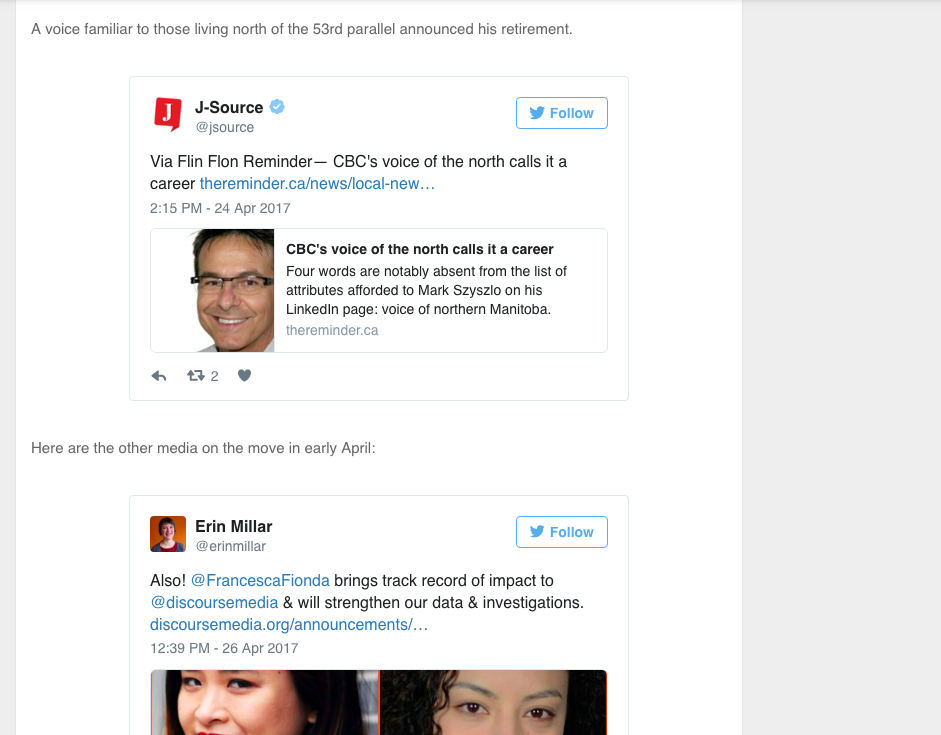Tweets aren’t in the public domain, despite what you might think.
By Andree Lau
Tweets are the new streeters. Want to take the public’s temperature on an issue? Slap a couple of tweets into an online or broadcast story and you’ve nailed the vox populi.
Can’t dispatch a photographer or videographer to a scene? Oh look, a helpful neighbour has posted Facebook video and another has shared photos to Instagram. We’ll grab those too, thank you.
Social media has made news coverage easier in so many ways, yet should not diminish clear legal and ethical guidelines for journalists and newsrooms.
First, the legal stuff
Let’s clear this up right now: Social media posts are not actually in the “public domain,” which means they do not belong to the public and are subject to copyright.
According to both Twitter and Facebook’s terms of service, for example, the person who posts the content (including text, photos, and video) owns it. That means the original material would be protected under Canada’s Copyright Act.
However, journalists are allowed to use such social media content as part of relevant news reporting under an exemption of the act known as “fair dealing” — as long as the author and source are clearly identified.
The easiest and most transparent way to do this is by using the embed codes provided by the social platform, which allows the post to remain in its native format. And no, you don’t need to ask the user’s permission. (More on that later.)
Simon Little, a digital reporter for Vancouver radio station CKNW, told me: “Our policy is that so long as the post is public and the embed feature is live, we may use it by embedding it into the story. This is encouraged.”
When is it fair game?
Those same terms of service I mentioned above go on to state that by using a platform’s services, a user has granted the company — for example, in Twitter’s case —“a worldwide, non-exclusive, royalty-free license (with the right to sublicense) to use, copy, reproduce, process, adapt, modify, publish, transmit, display and distribute” such content. That extends to “other companies, organizations or individuals for the syndication, broadcast, distribution, promotion or publication of such Content on other media and services.”
Basically, once someone has posted something, it’s fair game.
“The terms of use … aren’t just a contractual thing, but can also become an implied waiver of their rights over the copyright and the work,” explained Brian MacLeod Rogers, a media lawyer and adjunct professor at the Ryerson School of Journalism.
So do media outlets have the right to download photos and video without asking the user? Again, yes — as long as the author and source are clearly credited, and the material is relevant to the story.
(And what if it’s from another media company or journalist? Technically, it falls under the same “fair dealing” umbrella — but many outlets still don’t want to acknowledge competitors by showcasing their work.)
Getting it right
Journalists don’t have a legal obligation to contact social media users and ask them for permission, but there are compelling reasons to do it anyway. Like ethics and accuracy.
Relying solely on tweets means there’s no way of independently corroborating that information. How do you know if it’s accurate, if it’s lifted from elsewhere, if it’s recent, etc.
Also, someone who posted an incredible photo or video will have more info — and likely more footage — to share if you make contact with him/her. Based on my experience, 99% of people on social media are more than happy to give permission to use their content, and to elaborate on it. They like being asked, and you’ll probably create a better story for it.
Be warned though, asking for permission gets complicated.
“There’s always a greater risk if you ask for permission and it’s refused but you go ahead and use it, versus just taking the thing and using it,” said Rogers.
Seeking permission
Ron Waksman, vice-president of digital for Global News and Corus Radio, oversees Global’s editorial standards and practices. He said: “It can be complicated. There are situations where we can rely on fair dealing to post photos and video from social sharing sites, then there are also times when seeking permission is the best option.”
This is particularly important for difficult or sensitive stories, such as those involving children, where taking the time to respectfully contact people goes a long way towards delivering a nuanced story.
At HuffPost Canada, we do not ask for permission to embed tweets when they’re used to illustrate reactions to news (the “streeters,” if you will). We do seek permission for content that does not have embeddable options, or requires further verification and details (“where and when exactly was that flood video taken?”).
Rogers, the media lawyer, advises newsrooms not only to have explicit social media policies, but also to ensure that staff are aware of and will actually comply with them.
“I think every newsroom is well-advised to talk about these issues,” he said.
Andree Lau is the editor in chief of HuffPost Canada. A Carleton University alumnus, she previously worked as a TV reporter, videojournalist, producer, and online writer for CBC News in Vancouver, Edmonton, Calgary, Regina, Ottawa, Toronto, Fredericton, Moncton and Bathurst, N.B.

